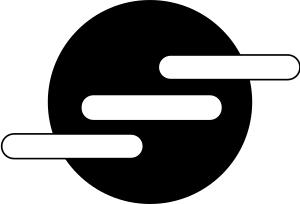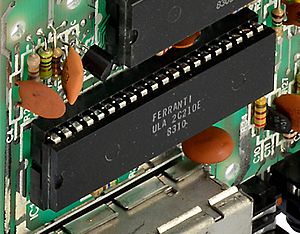Ferranti facts for kids
 |
|
| Public | |
| Industry | Electronics & Defence |
| Fate | Bankrupt & broken up |
| Successor | GEC-Marconi, Matra Marconi Space |
| Founded | 1885 (as S. Z. Ferranti); 1905 (as Ferranti Ltd) |
| Defunct | Bankrupt 1993 (the Belgian subsidiary lives on as Ferranti Computer Systems and as of 1994 is part of the Nijkerk Holding) |
| Headquarters | Hollinwood, Greater Manchester, United Kingdom |
|
Key people
|
Sebastian Ziani de Ferranti |
Ferranti was a big UK company that made electronics and engineering equipment. It operated for over 100 years, from 1885 until it faced financial difficulties in 1993. Ferranti was once one of the top 100 companies in the UK.
The company was famous for its work in power grid systems, which deliver electricity, and for its defence electronics. In 1951, Ferranti also started selling one of the very first computers, called the Ferranti Mark 1. Today, a part of the company in Belgium still exists as Ferranti Computer Systems.
Contents
The Story of Ferranti
How Ferranti Started
Sebastian Ziani de Ferranti started his first business in 1882. It was called Ferranti, Thompson and Ince. They created a special type of power generator. Dr. Ferranti was an expert in alternating current (AC) power, which is how most electricity is delivered today.
In 1885, Dr. Ferranti started a new company, S. Z. de Ferranti. He was very good at making electricity meters, which measure how much electricity people use. These meters were very important for his business to grow. Ferranti became a key supplier of meters for many power companies.
In 1887, a company called London Electric Supply Corporation (LESCo) hired Dr. Ferranti. He designed their power station at Deptford. When it was finished in 1890, it was a very modern power station. It sent out high-voltage AC power at 10,000 volts. This power was then changed to a lower voltage for homes and businesses.
Ferranti became successful and started making other electrical equipment, especially transformers. The company needed more space to build things. Land in London was too expensive, so they moved to Hollinwood in Oldham in 1896. In 1901, Ferranti Limited was formed. However, the company faced financial problems and went into receivership in 1903. This means it was taken over by others to manage its debts.
The business was reorganized in 1905. For the next eleven years, Dr. Ferranti was less involved in the company's business decisions. He spent time working on other projects, like cotton spinning machines.
Growing Bigger
In the early 1900s, many small companies supplied power. Each one used different standards, which made it hard to mass-produce electrical items for homes. In 1910, Dr. Ferranti spoke about this problem to the IEE. It took another 16 years for the National Grid to start in 1926. The National Grid connected all power stations in Britain.
In 1912, Ferranti started a company in Canada, Ferranti Electric. They wanted to sell meters overseas. In 1914, World War I began. This gave Dr. Ferranti a chance to get more involved in the company again. Ferranti started making shells and fuzes for the war effort. This work helped the company become financially stronger.
High-voltage power transformers became a very important product for Ferranti. Some of these huge transformers weighed over 100 tons. Dr. Ferranti's son, Vincent, joined the company in 1921. He helped expand the transformer business. After his father died in 1930, Vincent became the chairman.
In 1935, Ferranti bought a factory in Moston. Here, they made many home electronics like televisions, radios, and electric clocks. The company later sold its radio and TV businesses in 1957. Ferranti also built a new transformer factory in Hollinwood in the 1950s.
By 1974, Ferranti was a major supplier to the defence industry. But its power transformer division was losing money. This caused big financial problems. The government's National Enterprise Board had to help the company. They took a 65% share of Ferranti to save it.
Electronics for Defence
During World War II, Ferranti became a key supplier of electronics. They made fuzes and valves. They were also involved in creating the early radar system called Identification Friend or Foe (IFF). After the war, this became a big part of the company. They supplied radar sets, avionics (aircraft electronics), and other military electronics.
In 1943, Ferranti opened a factory in Edinburgh, Scotland. They made gyro gunsights for Spitfire aircraft there. After the war, this business grew a lot. It became a major part of the Scottish electronics industry. Later, they made advanced laser gyros.
From 1949, Ferranti-Packard helped the Royal Canadian Navy develop DATAR. This was a new computer system for battlefields. It combined radar and sonar information. This helped commanders see the whole battlefield. They could then plan attacks on submarines and aircraft.
In the 1950s, Ferranti worked on radar for aircraft. They supplied radars for most of the UK's fast jets and helicopters. Today, the Edinburgh site (now part of Leonardo S.p.A.) helps make the radar for the Eurofighter Typhoon jet.
In the 1960s and 1970s, inertial navigation systems became important. These systems help planes, rockets, and vehicles know where they are. Ferranti made systems for jets like the Harrier and Tornado. They were also used in the ESA Ariane 4 and Ariane 5 rocket launches. Ferranti also made PADS, a navigation system for British Army vehicles.
When the laser was invented in the 1960s, Ferranti quickly started using it. From the early 1970s, they made laser rangefinders for Jaguar and Harrier jets. They also made the world's first portable laser device for the British Army in 1974. Their TIALD Pod (Thermal Imaging Airborne Laser Designator) has been used in many conflicts since the first Gulf War.
From the 1960s to the late 1980s, the Bristol Ferranti Bloodhound SAM missile was a big earner. Ferranti developed the radar systems for it. In 1970, Ferranti also started working on sonar systems for ships. This work grew, and they won a contract for the Sonar 2050 system. This business later became Ferranti Thomson Sonar Systems.
Computers and Technology
In the late 1940s, Ferranti worked with universities to develop computers. Their first computer was the Ferranti Mark 1, finished in 1951. They sold about nine of these. The Pegasus, launched in 1956, was their most popular computer using valves. They sold 38 of these.
Ferranti also worked with the Victoria University of Manchester. They built a new version of the Mark 1. It used newer solid state parts instead of valves. This made the computer much faster and more reliable. Ferranti sold this new computer as the Ferranti Mercury starting in 1957. They sold 19 of them.
Work on a completely new computer, the Atlas, began soon after. Ferranti continued to work with the University of Manchester. The Atlas was a very powerful second generation supercomputer. It first ran in December 1962. Six Atlas machines were built. One was used at the University of Cambridge Mathematical Laboratory and was called the Titan. The Atlas was the first computer in the world to use virtual memory. This allowed computers to use more memory than they physically had.
By the early 1960s, Ferranti's mid-size computers were not selling well. The Canadian division, Ferranti-Packard, created the Ferranti-Packard 6000. Ferranti decided to sell its computer division. It was merged into International Computers and Tabulators (ICT) in 1963. This became part of ICL in 1968.
Ferranti was not allowed to make computers for general business after this deal. But they could still make industrial computers. They used some of the technology from the FP 6000 in their Ferranti Argus range of industrial computers. These were made in their Wythenshawe factory. The first Argus was first made for military use.
Meanwhile, in Bracknell, another division made mainframe computers for naval ships. These included the Hermes and Poseidon. Later, they made the F1600 in the mid-1960s. Some of these computers were used on naval ships for many years. The FM1600B was the first to use integrated circuits. It was used in many naval and commercial systems. The FM1600E was an updated version. The last in this series was the F2420, which was still used at sea in 2010.
Semiconductors and Microchips

Ferranti had been making electronic parts like radio valves and cathode-ray tubes for a while. In 1955, it became the first European company to make a silicon diode. In 1972, they launched the ZN414, a single-chip AM radio integrated circuit.
Ferranti Semiconductor Ltd. made many silicon devices. In 1977, they made the Ferranti F100-L. This was an early 16-bit microprocessor. An F100-L chip was even carried into space on a satellite called UoSAT-1.
In the early 1980s, Ferranti made some of the first large uncommitted logic arrays (ULAs). These were special chips used in early home computers. Examples include the Sinclair ZX81, Sinclair ZX Spectrum, Acorn Electron, and BBC Micro. The microelectronics part of the business was sold in 1988.
The End of Ferranti
In 1987, Ferranti bought a US defence company called International Signal and Control (ISC). Ferranti then changed its name to Ferranti International plc. The combined company was reorganized into different divisions.
However, Ferranti did not know that ISC's business mainly involved secret and unauthorized arms sales. On paper, ISC looked very profitable. But these profits were not real. When Ferranti bought ISC, these secret sales stopped. This left the company with no real money coming in.
The financial and legal problems from this situation forced Ferranti into bankruptcy in December 1993.
Where Ferranti Operated
Ferranti had many factories in the UK. These included locations in Hollinwood, Moston, Chadderton, Waterhead, Derker, Wythenshawe, Cheadle Heath, West Gorton, and Poynton.
They also had branch factories in Scotland, including Edinburgh, Dalkeith, Aberdeen, Dundee, and Kinbuck. Other UK locations included Bracknell, Barrow in Furness, and Cwmbran. Ferranti also had offices and operations in Germany, the United States, Canada, Australia, and Singapore.
Ferranti Defence Systems made many products for aircraft cockpits. These included displays, video cameras, night vision goggles, and pilot controls. For the Tornado aircraft, Ferranti supplied the radar, navigation system, laser rangefinder, and cockpit displays.
What Happened to Ferranti's Businesses?
After Ferranti faced financial difficulties, many of its different business parts were sold off to other companies. Here are some examples:
- Ferranti Autocourt (petrol station pumps) was bought by Wayne Dresser.
- Ferranti Communications was bought by Thorn EMI.
- Ferranti Computer Systems (the Belgian part) is now part of Nijkerk Holding. Other parts were bought by SYSECA (later Thales) and GEC-Marconi.
- Ferranti Defence Systems was bought by GEC-Marconi and later became part of BAE Systems and Selex ES.
- Ferranti Dynamics was bought by GEC-Marconi in 1992.
- Ferranti Semiconductors became Zetex Semiconductors and was later bought by Diodes Inc.
- Ferranti Technologies was bought by its management and continues to make avionics and defence electronics in Oldham. It was later acquired by Elbit Systems and then by TT Electronics.
- Ferranti Thomson Sonar Systems is now owned by Thales.
Other Uses of the Ferranti Name
Even though the main company is gone, the Ferranti name is still used in some places. In Edinburgh, there are still clubs like the Ferranti Edinburgh Recreation Club and the Ferranti Mountaineering Club.
A football team called Ferranti Thistle F.C. was formed in 1943. It later changed its name to Meadowbank Thistle F.C., and then to Livingston F.C..
Denis Ferranti Meters Limited is a company still owned by a direct descendant of Sebastian de Ferranti. It makes things like public phones, oil pumps, electric motors, and electronics. It is not directly related to the large Ferranti corporation that went bankrupt.
Images for kids
-
Ferranti 837 All-Wave Superhet radio (1937), made of Bakelite







